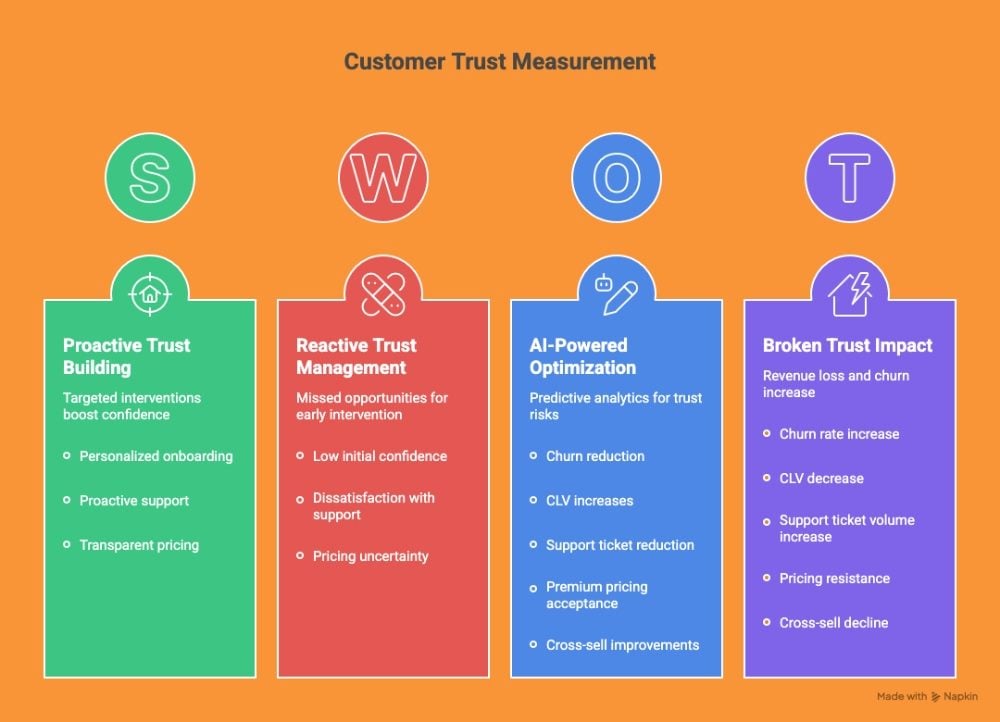The Gist
- Customer trust must be measured. Managing customer trust requires systematic measurement using sentiment analysis, NPS tracking, and behavioral indicators that predict loyalty and lifetime value.
- Analytics-driven trust interventions. There are many proactive trust-building measurements for analysis, such as using sentiment analysis, NPS tracking, and behavioral indicators for predict loyalty and lifetime value.
- AI-enhanced trust monitoring. Machine learning and AI models can predict trust erosion through behavioral patterns, support ticket sentiment, and engagement anomalies across touchpoints.
- ROI of trust investment. Trust-building initiatives generate measurable returns through reduced churn, increased lifetime value, and premium pricing acceptance—metrics that justify analytics investment.
Gaining customer trust has long been cherished among executive teams as a way to build brand value. Traditional metrics have been central for managing customer trust.
But digital media and associated messaging has required an update of how customer trust metrics should be analyzed. Now marketing managers need sophisticated trust analytics frameworks to measure, monitor and optimize their trust-building initiatives.
Unlike traditional customer satisfaction metrics, trust analytics provides predictive insights that connect emotional sentiment to measurable business outcomes. This evolution becomes particularly crucial given current market conditions.
For marketing teams operating under budget constraints—with marketing budgets flatlining at 7.7% of overall company revenue according to Gartner's 2025 CMO Spend Survey—trust analytics offers a pathway to sustainable competitive advantage.
Table of Contents
- Why Customer Trust Analytics Drives Business Growth
- Essential Trust Metrics for Marketing Analytics
- Core Trust Measurement Framework
- AI-Powered Trust Analytics Tools
- Implementing Trust Measurement By Customer Journey Stage
- How Customer Journey Analytics Supports Trust Measurement
- Key Trust-Building Moments in the Customer Journey
- Trust Analytics Leads to Business Impact and ROI
Why Customer Trust Analytics Drives Business Growth
Traditinal customer metrics often lag behind trust indicators, missing critical early warning signals that predict customer behavior changes. Trust analytics provides leading indicators that connect emotional sentiment to revenue impact through measurable customer actions.
The business case for trust measurement has become compelling. According to eMarketer’s recent Consumer Trust Research, 81% of consumers need to trust a brand before buying from it, while 67% require trust to continue purchasing. When 69% of marketing leaders report that executive leadership now expects quantifiable, measurable results for everything their department does—up from 59% two years ago—trust analytics provides concrete metrics that justify investment.
Another analysis, Edelman’s 2025 Trust Barometer report, discovered that 88% of consumers feel distrust is a dealbreaker when purchasing products or services. The report also revealed that 87% of consumers will pay more for brands they trust, while 70% report that business leaders deliberately mislead them through false or exaggerated claims. These sentiments reflect how much customer trust has become vital to business performance.
Related Article: Building Customer Trust — Statistics in the US for 2025
Essential Trust Metrics for Marketing Analytics
Effective trust measurement requires a comprehensive framework capturing leading and lagging indicators across customer touchpoints. The most successful approaches combine quantitative behavioral data with qualitative sentiment analysis.
Core Trust Measurement Framework
Marketers have traditionally used a number of traditional metrics, such as Net Promoter Score (NPS) or Customer Effort Score (CES), to rate the quality of a customer experience. The addition of digital media within the customer experience has introduced additional metrics and techniques. Metrics marketers have adopted include purchase frequency, renewal rates and cross-sell conversion metrics. Frameworks such as customer churn have been designed to reveal engagement patterns.
The metrics and frameworks underlie the queuing services customers typically encounter, such as purchase orders and support ticket systems.
AI-Powered Trust Analytics Tools
Marketers use a range of analytics frameworks to evaluate customer trust. AI enhances these processes by automating repetitive tasks, spotting patterns earlier and surfacing signals leaders might otherwise miss. The table below outlines common analysis types and where AI makes the biggest impact.
| Analysis Type | Available Solutions | Key Features to Monitor Customer Trust |
|---|---|---|
| Customer Sentiment Analysis | Lexalytics, MonkeyLearn | Real-time sentiment classification, emotion detection, conversational tone shifts |
| Predictive Analytics | CustomerAI, Gainsight | Churn risk prediction, trust score modeling, early-warning indicators |
| Journey Analytics | Amplitude, Adobe Analytics | Cross-touchpoint trust measurement, drop-off analysis, friction identification |
These analyses enable sophisticated trust measurement without requiring dedicated data science resources, providing enterprise-level insights with constrained budgets.
Implementing Trust Measurement By Customer Journey Stage
Successful trust analytics requires systematic measurement across customer journey stages, connecting trust indicators to specific touchpoints where experience improvements drive business impact.
Understanding the customer journey is vital for getting the customer experience with trust-building activities right.
How Customer Journey Analytics Supports Trust Measurement
Trust signals emerge across the customer journey—not at a single moment. Customer journey analytics software helps unify these signals by combining behavioral data, sentiment indicators and cross-channel interactions into a single, interpretable view. This gives marketing teams the visibility needed to understand where trust grows, where it erodes, and where targeted interventions can drive measurable impact.
Customer journey analytics platforms integrate data from web activity, mobile usage, paid media, email engagement, support interactions and offline experiences. By layering trust indicators—such as dips in sentiment, support friction, or behavioral anomalies—onto journey maps, marketers can pinpoint the exact stage where trust weakens and take corrective action quickly.
Modern systems use machine learning to detect emerging risks, predict customer intent, and highlight the interactions that influence loyalty and retention. This elevates trust analytics from isolated scorecards to a connected, journey-wide measurement system.
Related Article: What Is Customer Journey Analytics Software?
Customer Journey Analytics Tools for Trust Measurement
The table below highlights leading journey analytics tools and how they support trust measurement across customer touchpoints.
| Tool | Primary Strength | Trust-Focused Use Cases |
|---|---|---|
| Adobe Journey Optimizer | Unified real-time journey orchestration | Detects drop-offs, sentiment changes, and trust-impacting friction across channels |
| Amplitude | Behavioral product analytics | Identifies engagement patterns tied to trust, such as declining activity or feature abandonment |
| Salesforce Marketing Cloud Intelligence | Cross-channel data integration and modeling | Correlates trust scores with campaign performance and customer journey stages |
| Sprinklr Insights | AI-powered journey and sentiment analysis | Surfaces trust risks from social, messaging, and support data in real time |
The measurement of customer trust can be broken down into a sequence of events:
- Acquisition: Brand perception scores, ad credibility ratings, first-impression sentiment
- Onboarding: Setup completion rates, time-to-first-value, and early satisfaction correlation
- Engagement: Product usage depth, support ticket sentiment, self-service success rates
- Retention: Renewal probability, advocacy behavior, expansion opportunity indicators
Key Trust-Building Moments in the Customer Journey
Trust is built or broken in specific moments across the journey. Identifying these interactions helps marketers intervene with precision and measure the impact in ways that reflect real customer confidence. The table below outlines several critical moments and how to monitor them.
| Trust-Building Interaction | Recommended Intervention | Recommended Metrics |
|---|---|---|
| Low initial confidence | Personalized onboarding paired with clear success assurances | Time-to-value, onboarding completion rate |
| Dissatisfaction with customer support | Proactive outreach and assignment of dedicated support resources | Sentiment change, first-contact resolution, case resolution time |
| Pricing or value uncertainty | Transparent pricing explanations with ROI and value calculators | Purchase activity, upgrade rates, conversion rate lift |
You can create a framework that roadmaps how known instances are linked, such as a customer service activity that must occur prior to a case resolution. The measurement of the linked activities can indicate how trust is shared and weighed across a suite of trust-building activities.
Once you have established a roadmap for the opportunities, you can start to plan where machine learning or AI would be a complement to a trust-building interaction. Artificial intelligence transforms trust analytics from reactive reporting to automated optimization, enabling marketing teams to better identify trust risks before they occur.
The list below shows example instances where success with applied customer trust analytics is possible:
- Churn rate reduction among high-trust customer segments
- Customer lifetime value increases are correlated with trust score improvements
- Support ticket volume reduction through improved customer confidence
- Premium pricing acceptance among high-trust customers
- Cross-sell and upsell conversion improvements
The result that should occur from a marketing team’s choice of a customer trust measurement is a better management of customer relationships and a significant revenue performance that reflects customer spend.

Trust Analytics Leads to Business Impact and ROI
Investments in trust analytics require a clear ROI demonstration through measurable improvements in customer retention, lifetime value and operational efficiency. Marketing teams must connect trust improvements to consistent business outcomes.
Organizations that excel at trust analytics embed trust measurement into every aspect of marketing operations, from campaign planning to customer success management. This approach ensures consistent trust-building across all customer interactions.
Learn how you can join our contributor community.
